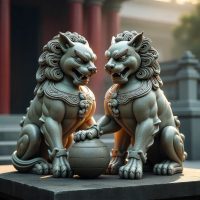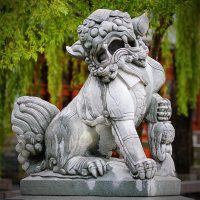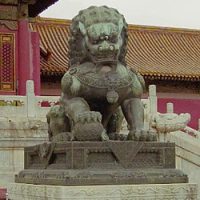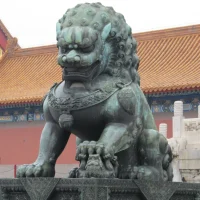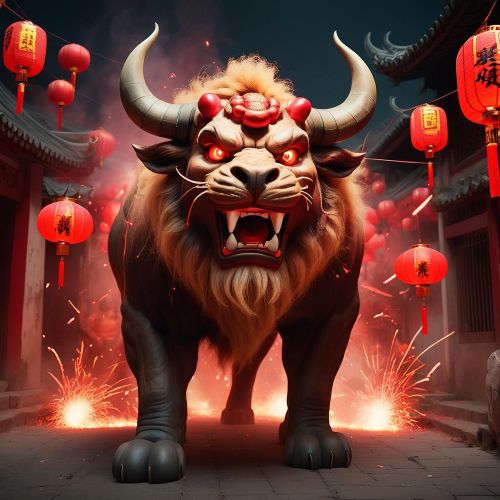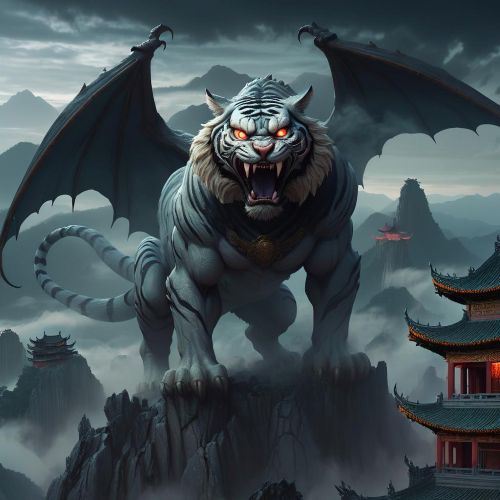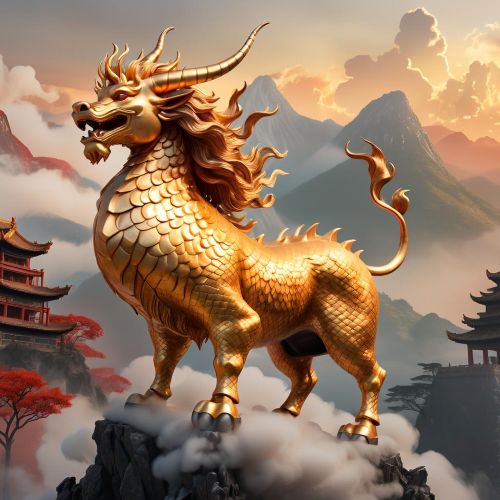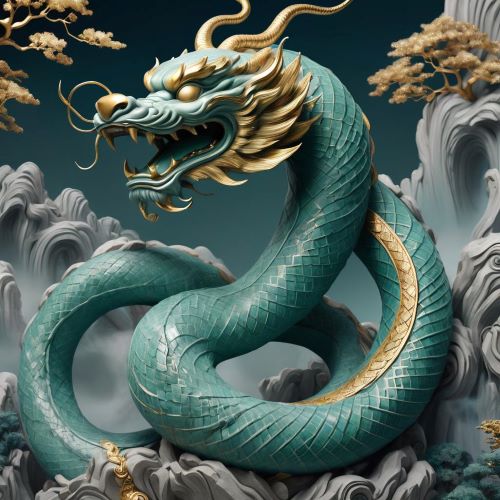Shishi : The Sacred Lion Guardians of Ancient China
Listen
At a glance
| Description | |
|---|---|
| Origin | Chinese Mythology |
| Classification | Hybrids |
| Family Members | N/A |
| Region | China |
| Associated With | Protection, Temples |
Shishi
Introduction
Shishi, commonly recognised as Chinese guardian lions, are among the most enduring and influential symbols of protection in East Asian mythology. Though often called “lions,” their forms are highly stylised interpretations inspired by cultural exchanges with regions where real lions lived. As early as the Han Dynasty, Chinese artists adopted the lion motif from Buddhist imagery brought from India, linking these mythical creatures to spiritual authority and divine guardianship. Over centuries, Shishi became fixtures at the entrances of temples, palaces, tombs, imperial courts, and elite homes, serving not only as physical sculptures but also as potent symbols of power, fortune, and cosmic order. Their role as protectors is woven deeply into Chinese religious and architectural traditions, and their presence continues to shape cultural, artistic, and spiritual landscapes across the world.
Physical Traits
Although inspired by the lion, Shishi are not realistic depictions of the animal. Instead, they embody an artistic fusion of lion-like strength with mythical embellishments. They typically appear with broad, muscular bodies, large paws, bulging eyes, and exaggerated curly manes arranged in spirals or flame-like patterns. Their expressions vary between fierce, vigilant, and majestic depending on the cultural period and artistic school. Traditionally made of stone, bronze, or ceramic, these statues are always presented in pairs—one male and one female—placed symmetrically on either side of an entrance.
The male Shishi is depicted with a ball beneath his paw, symbolising mastery over worldly matters and the safeguarding of the structure itself. The female holds a cub, signifying protection of life, family, and the people residing inside. Their open and closed mouths are believed to represent the sacred sounds “A” and “Um,” the beginning and end of all existence in Buddhist philosophy. While some designs exaggerate canine or dragon-like features, these creative variations only enhance their mythical aura and reinforce their supernatural purpose.
Family
Unlike many mythological beings, Shishi do not belong to a narrative family tree. Their symbolic pairing is what defines their mythic identity. Together, the male and female embody yin and yang, balancing opposing yet complementary energies. The male represents action, external strength, and authority; the female reflects nurturing, internal harmony, and continuity. Their dual presence ensures that both the physical structure and the people within are shielded from misfortune and negative influences.
This symbolic “family unit” has influenced interpretations across Asia. In some traditions, the cub under the female’s paw is seen as her offspring, representing prosperity and lineage. In Buddhist spaces, Shishi are also linked to the lion as a metaphor for the Buddha’s voice—powerful, truth-bearing, and capable of dispelling illusion. Their guardianship thus extends beyond physical boundaries, protecting spiritual purity and moral order.
Other names
Shishi are known by many names across different cultures, illustrating their widespread influence. In English, they are often called Foo Dogs or Fu Dogs, terms thought to derive from the Chinese word fu (福), meaning blessing or good fortune, though this is a Western reinterpretation rather than an authentic Chinese term. They are also described as lion dogs, emphasising their hybrid appearance.
In Chinese, shíshī (石獅) literally means “stone lion,” while shī (獅) refers simply to the lion creature. The concept has also travelled widely: in Japan, they evolved into komainu and kara-shishi; in Myanmar, they appear as Chinthe; in Thailand and Cambodia, similar guardian lions are called Singha or Simha, derived from the Sanskrit siṃha. This linguistic and cultural diversity shows how the guardian lion motif adapted to local aesthetics while maintaining its fundamental role as a sacred protector.
Powers and Abilities
Shishi are renowned for their supernatural abilities, most of which revolve around protection and auspicious fortune. They are believed to repel evil spirits, harmful energies, and malevolent intentions simply through their presence. In Feng Shui, placing Shishi at entrances strengthens the flow of positive qi, wards off misfortune, and enhances prosperity. Their symbolism is closely tied to authority—historically, only those with imperial permission could place large Shishi at their gates, marking them as icons of status, legitimacy, and spiritual favour.
Beyond their protective qualities, Shishi are seen as bringers of success, wealth, and longevity. In ceremonial traditions such as the lion dance, the Shishi’s mythical roar is said to drive away chaos and usher in blessings for the community. Some artistic representations show Shishi holding a sacred jewel, signifying enlightenment, wish fulfilment, and access to divine wisdom. Through these interpretations, Shishi become more than guardians; they represent the harmony between the material and spiritual realms.
Modern Day Influence
Shishi retain remarkable cultural significance in the modern world. Their statues continue to guard temples, businesses, homes, and government buildings across China and in communities throughout the Asian diaspora. Their iconic design appears in interior décor, jewellery, tattoos, and luxury branding, where they symbolise security, sophistication, and cultural pride. The lion dance, rooted in the Shishi tradition, remains an essential part of Lunar New Year celebrations, believed to invite good luck and protect against misfortune.
In global media, Shishi-inspired creatures appear in films, manga, anime, and games such as World of Warcraft, Final Fantasy, and Genshin Impact, often portrayed with magical abilities that echo their ancient protective functions. Their adaptability in both traditional and digital settings underscores their lasting appeal. Despite technological change and modern architectural styles, Shishi continue to stand as guardians bridging ancient belief with contemporary culture, symbolising strength, prosperity, and enduring heritage.
Related Images
Source
Chinese guardian lions. (2004, June 20). In Wikipedia. Retrieved November 17, 2025, from https://en.wikipedia.org/wiki/Chinese_guardian_lions
Shisa. (2004, May 30). In Wikipedia. Retrieved November 17, 2025, from https://en.wikipedia.org/wiki/Shisa
Shíshī – The Demonic Paradise Wiki. (2007, December 31). Retrieved November 17, 2025, from https://the-demonic-paradise.fandom.com/wiki/Shíshī
Myth and Folklore Wiki. (n.d.). Chinese Guardian Lions. https://mythus.fandom.com/wiki/Chinese_Guardian_Lions
Littleton, C. S. (2002). Mythology: The Illustrated Anthology of World Myth and Storytelling. Duncan Baird Publishers.
Yang, L. (2005). Handbook of Chinese Mythology. Oxford University Press.
Eberhard, W. (1986). A Dictionary of Chinese Symbols: Hidden Symbols in Chinese Life and Thought. Routledge.
Rawson, J. (1995). Chinese Ornament: The Lotus and the Dragon. British Museum Press.
Wong, E. (1997). Feng Shui: The Ancient Wisdom of Harmonious Living for Modern Times. Shambhala Publications.
Frequently Asked Questions
What do Shishi symbolize in Chinese culture?
Shishi represent protection, prosperity, and balance, traditionally placed at entrances to guard against negative influences.
Why are Shishi always in pairs?
The pair represents yin and yang—male and female energies balancing each other to protect both the building and its inhabitants.
What is the difference between a male and female Shishi?
The male holds a ball symbolising authority and protection of the structure, while the female guards a cub representing family and nurturing.
Are Shishi the same as Foo Dogs?
Foo Dogs is a Western term; the authentic name is Shishi or Chinese guardian lions.
Do Shishi have significance in Feng Shui?
Yes. Proper placement of Shishi enhances positive energy, wards off misfortune, and attracts prosperity.


